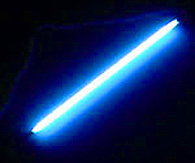fluorescent lighting
Fluorescent lamps use 25–35% of the energy used by incandescent lamps to provide the same amount of illumination (efficacy of 30–110 lumens per watt). They also last about 10 times longer (7,000–24,000 hours).
 |
The light produced by a fluorescent tube is caused by an electric current conducted through mercury and inert gases. Fluorescent lamps require a ballast to regulate operating current and provide a high start-up voltage. Electronic ballasts outperform standard and improved electromagnetic ballasts by operating at a very high frequency that eliminates flicker and noise. Electronic ballasts also are more energy-efficient. Special ballasts are needed to allow dimming of fluorescent lamps.
Improvements in technology have resulted in fluorescent lamps with color temperature and color rendition index that are comparable to incandescent lamps.
Types of fluorescent lamps
Two general types of fluorescent lamps include these:
You can use the chart below to compare these types of lamps.
| Fluorescent lighting type | Efficacy (lumens/watt) |
Lifetime (hours) |
Color rendition index (CRI) |
Color temperature (K) |
Indoors/outdoors |
| Straight tube | 30–110 | 7000–24,000 | 50–90 (fair to good) | 2700–6500 (warm to cold) | Indoors/outdoors |
| Compact fluorescent lamp (CFL) | 50–70 | 10,000 | 65–88 (good) | 2700–6500 (warm to cold) | Indoors/outdoors |
| Circline | 40–50 | 12,000 | Indoors |
